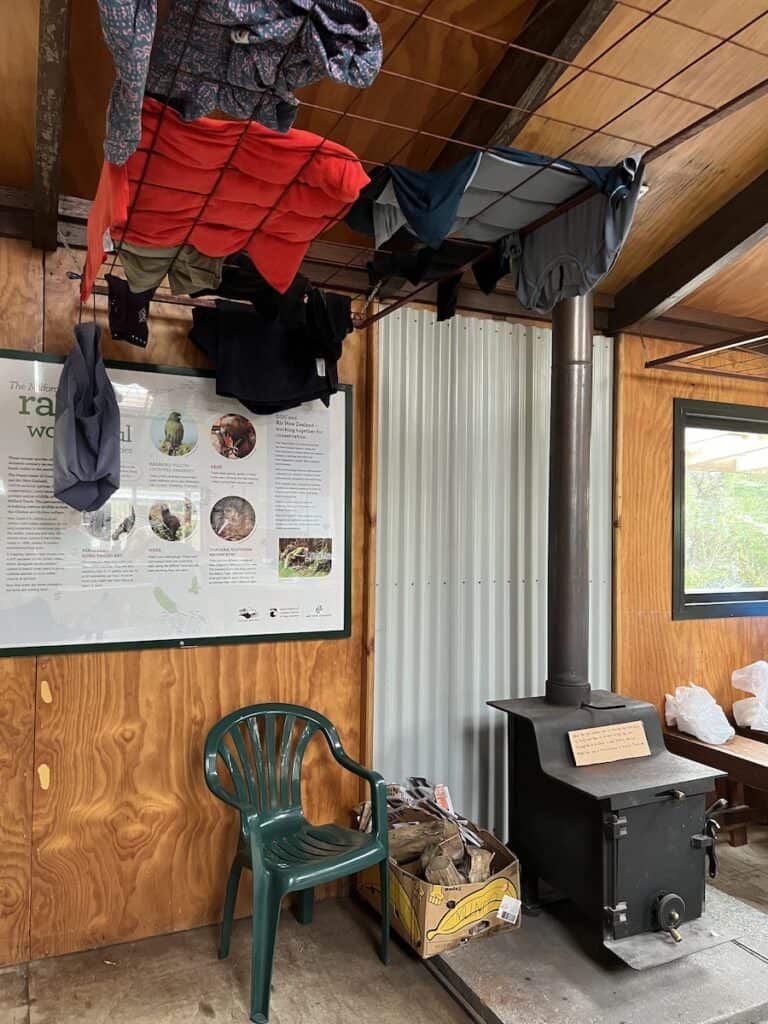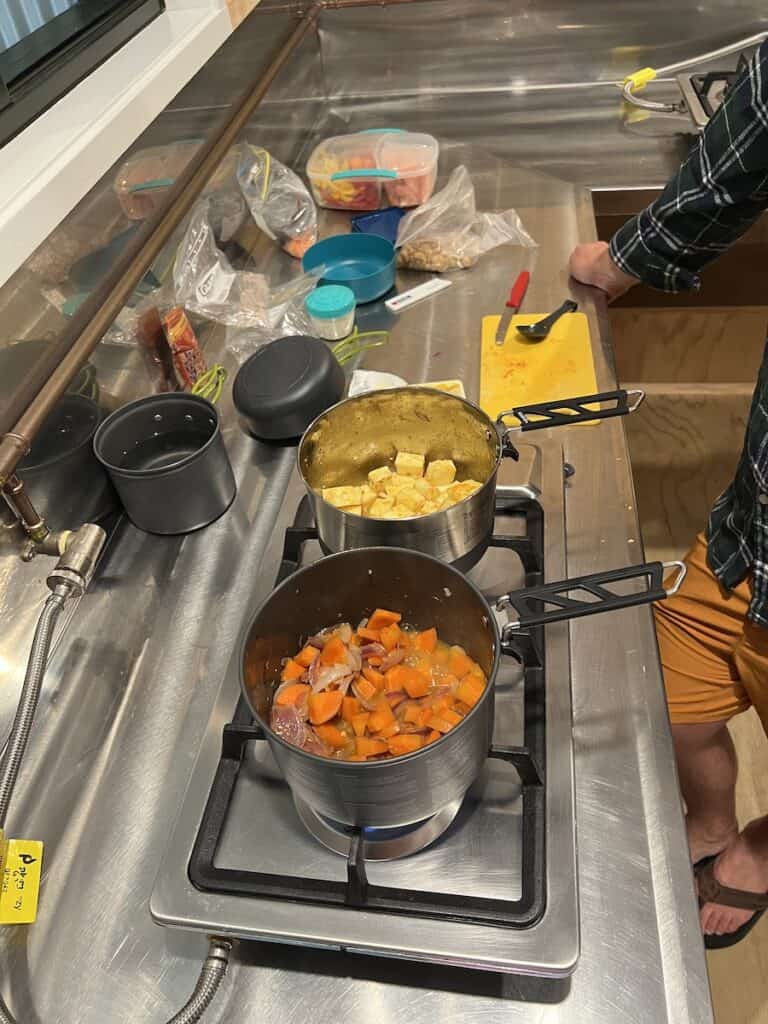Sleeping in the shared huts is all part of the fun when hiking the Milford Track. These rustic wooden cabins have all the basics you need to eat, rest, and decompress after a long day of hiking. They’re also run by some big personalities who may also be element benders? Here’s everything you need to know about the Milford Track Huts.
This post may contain affiliate links. Bookings or purchases through these links generate a small commission for me at no extra cost to you. Thanks for your support!
Facilities at the Milford Track huts
There are three Milford Track huts along the trail: Clinton, Mintaro, and Dumpling. Each has a different dorm configuration, but you’ll be sharing a room with another 12ish people, with 40 campers in total. It’s all a first come first served basis for choosing beds when you arrive, so you can’t guarantee you’ll be in the same room, get a bottom bunk, or find one next to your mates. That said, we were travelling as a group of 6 and always ended up near each other with 3 sets of bunks.
Things the Milford huts DO have
- Clean drinking water
- Flushing toilets, toilet paper, hand soap
- Gas burners for cooking
- Dish liquid, scrubbers, wet cloths
- Clothes lines/racks for drying clothes
- Windows with bug nets
Things the Milford huts DON'T have
- Showers
- Charging ports for any electronics
- Cell service
- Sheets/bedding
- Towels
- Garbage bins
- Fridge
- Pots, pans, cutlery, dishes, etc.
- Lights (solar, only on for brief periods)

Drying rack and fire heater

Gas stoves provided (our own cooking gear & food)

Bunks inside Clinton Hut
Cooking at the Milford Track huts
There are several auto-igniting gas burners in the kitchens, so all you need is your cooking gear. We never had to wait to use a stove and never felt crowded in the cooking spaces. There’s also lots of shelving space where you can leave your gear overnight so you don’t have to pack it away after every use.
While there are signs advising you to boil the water before drinking it, the DOC workers assured us it’s totally fine to drink on its own. The signs are just a legal requirement for the national parks to put up in every location. I drank the water all day every day and I was completely fine, so I approve this message
Activities
It only takes a couple hours to get to Clinton Hut on the first day, so I think it’s totally worth going on the nature walk with the DOC worker (see below). You can also see glowworms once it’s dark because they live on some of the foliage along the trail just outside the hut. Each hut is placed next to a river, which makes an excellent swimming spot if it’s not bucketing down rain. You should also bring a deck of cards or a book.
We usually took our time on the trails so we got to the huts later in the day and were pretty ready for bed after cooking dinner, but it’s still nice to have something to do if you have down time. How do we entertain ourselves without our phones?!



Fees for the Milford Track huts
As of May 2025, the cost of one night in a dorm is $106 for locals (residents, not just Kiwi citizens), and $152 for international hikers. The hike takes four days, and no, you can’t skip any of the huts if you’re speedy or camp with your own tent.
So that’s three nights of accom for a total of $318 per person if you have a piece of NZ ID. Or $456 if you’re visiting from abroad.
You can book the Milford Track huts here. You will need to be organized to pull this off. The booking page usually opens around May or June, with the hiking season starting in October and ending in April of the following year. The Milford Track booking site has crashed in previous years because so many people were online trying to book at the same time.
Me and two other friends were up early when the booking page opened. We had everything queued up for different dates, all ready to hit “Refresh” as soon as the portal opened at 9:30am sharp. I was the only one who was successful. So you need a bit of luck to make it work, but I’ve shared a few tips in another article to help increase your chances or securing a slot.
Side note: transport fees
I know you’re only here to learn about the Milford Track huts, but I also want to mention the cost of just getting to and from the trail. We hadn’t considered this part before securing our huts. It was a bit of a shock to the ol’ wallet, so hopefully this is helpful.
To get to the trailhead, you’ll need to take a bus and a boat, then catch another boat and bus to get you back. We booked with Fiordland Outdoors, which costs $332 per person. Yikes! But there’s no way around it, unless you feel like swimming.
Read more: The total cost of hiking the Milford Track

I have to tell you about the Milford Track huts DOC workers
These characters are a real part of the whole experience. There’s one Department of Conservation (DOC) worker at each hut, and while I think their primary purpose is to keep us all safe, they also provide a lot of entertainment. Each had at least one quippy, well-rehearsed joke about Australians that you could tell they worked hard to incorporate into their spiel every night.
Clinton Hut
We were greeted by a man who must have been 7 feet tall and 100 years old. In true New Zealand fashion, he had the presence of a wise old Ent. He had one cloudy eye and used a long wooden walking stick to lead us around the surrounding rainforest to teach us all about the plant life. He’d ask us questions like, “Why does this tree have foliage that grows so high?” Someone in the crowd would answer, “Because Moa ate them?” and he’d say, “What? No. Anyone else?” When no one answered, he’d finally give us the answer. “Moa used to eat them.”
Every word with an “S” he spoke came with a whistle between his teeth. He went through a mental list of about 10 native birds and told us all about each of them. I loved him so much. We never saw a staff hut for him to sleep in. I’m quite convinced he just retreats into the forest and becomes one of the trees every night.
He’s our air bender.
Mintaro Hut
He entered the dining room with a booming voice to welcome us to his house. He took great pride in his hut and the conservation efforts throughout the park.
As an ex-firefighter, he’s even more passionate about the risk of fire and made sure to point out the exact location of every fire extinguisher in the kitchen and detailed the process of evacuating the building. He reassured us he’d come running back into the building to save us if we somehow slept through the fire alarm.
He’s our fire bender.
Dumpling Hut
Even though we had three days of full sun, this DOC worker was obsessed the risk of flooding. To be fair, it’s not uncommon for Milford Sound to have roads and trails get flooded out and closed due to extreme weather. They’ve built all the Milford Track huts on high ground or on stilts for this very reason.
He told us several wild stories about how people got stranded in the huts because the track became flooded with water up to four metres high (That’s like two and a half people tall!!). He was obsessed with the storms he’s experienced over the years, and now I’m obsessed with him.
He’s our water bender.


As there’s no fourth hut, there can’t be an earth bender. But I like to think they’re all here to protect the earth, created by Tu-te-raki-whanoa, according to Māori legend.
Not so fun fact: New Zealand had no native mammals (except for bats) before Europeans colonized it, bringing rats, rabbits, stoats, possums, and other invasive species. These have been detrimental to the bird population and have even caused some species to become extinct.
Of course the DOC workers don’t all live there full time. I believe they do 8 days on, 6 days off. So you may meet some other characters, but the ones we met really left an impression. I like to think you’ll know instantly if you come across the same guys at the Milford Track huts.
Read more: What Are the Kepler Track Huts Like?
If the Milford Track huts aren't for you
You could still do a portion of the track by doing a day hike from Milford Sound. Catching a quick boat transfer over to Sandfly Point lets you explore the relatively flat last section of the trail. It’s beautiful, but I still have to say the Milford Track isn’t truly complete without a night in each of the huts.

